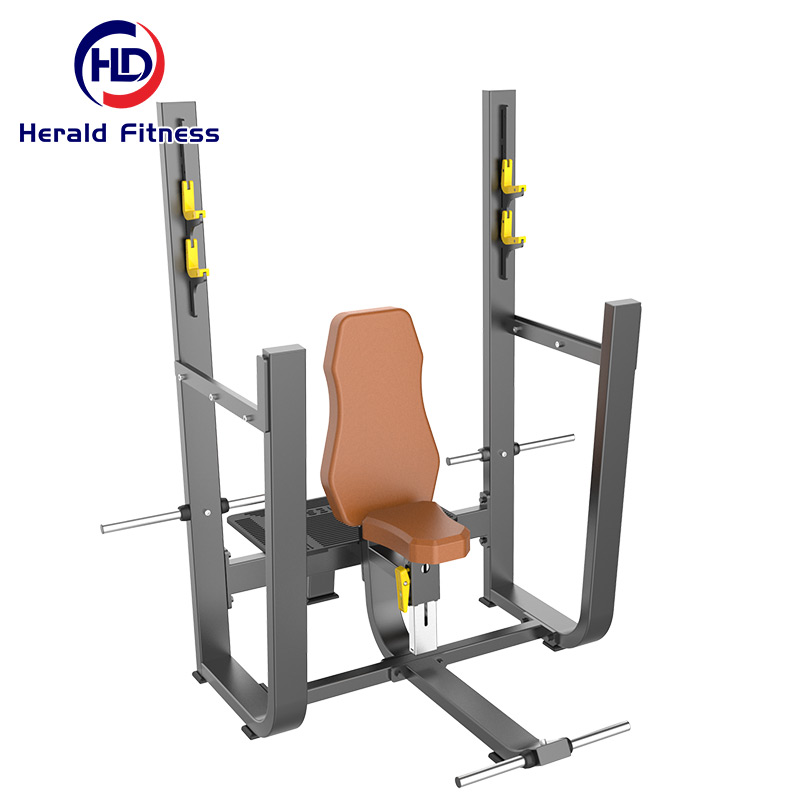The Olympic Seated Bench, also known simply as a Seated Bench or an Olympic Bench, is a versatile piece of gym equipment designed primarily for upper body strength training exercises. It provides a stable platform and adjustable settings to facilitate various pressing movements with a barbell. Here’s an introduction to its features, benefits, and typical uses:
Features of the Olympic Seated Bench
- Adjustable Backrest: Features an adjustable backrest that allows users to set different incline angles, from flat to various degrees of incline (e.g., 30 degrees, 45 degrees), depending on the exercise and personal preference.
- Sturdy Frame: Built with a robust frame typically made from steel or heavy-duty materials to provide stability and support during lifting.
- Barbell Rack: Includes a secure barbell rack positioned above the seat, equipped with J-hooks or barbell holders to safely hold and secure the barbell during exercises.
- Padding and Upholstery: Features padded cushions on the seat and backrest for comfort during exercises, often covered with durable upholstery for longevity.
- Foot Support: Some models may have foot supports or stabilizers to anchor the user’s feet and enhance stability during exercises.
Benefits of Using the Olympic Seated Bench
- Versatility: Supports a variety of upper body exercises, including bench presses (flat, incline, decline), shoulder presses, and seated arm exercises, targeting muscles such as the chest, shoulders, and triceps.
- Strength Development: Facilitates strength development and muscle hypertrophy in the upper body muscles through controlled resistance training with a barbell.
- Adjustability: Offers adjustable settings for the backrest angle, allowing users to target specific muscle groups and adjust the difficulty level of exercises.
- Safety: Provides a stable and secure platform for lifting heavy weights, minimizing the risk of injury during solo workouts.
- Progression: Allows for progressive overload by increasing the weight load gradually over time, helping users to continuously challenge their muscles and achieve fitness goals.
Typical Uses
- Bench Press: Performing various types of bench presses, including flat bench press, incline bench press, and decline bench press, using the adjustable backrest to target different areas of the chest and shoulders.
- Shoulder Press: Performing seated shoulder presses to target the deltoid muscles of the shoulders, adjusting the backrest to a vertical or slightly inclined position for optimal range of motion.
- Arm Exercises: Performing seated arm exercises such as bicep curls, tricep extensions, and overhead tricep presses, utilizing the stability of the bench for proper form and control.
Proper Usage
- Setup: Adjust the backrest to the desired incline angle or position for the specific exercise. Ensure the Olympic Bench is stable and positioned on a flat surface.
- Starting Position: Sit comfortably on the bench with your feet firmly planted on the floor or foot supports, depending on the exercise.
- Execution: Grasp the barbell with an appropriate grip width and perform the exercise with controlled movements, lowering the barbell to the chest or shoulders and pressing it upwards.
- Breathing: Inhale before lowering the barbell and exhale during the effort phase of each repetition.
- Repetitions: Complete the desired number of repetitions and sets based on your training goals and fitness level.
Tips for Effective Use
- Warm-Up: Warm up your upper body muscles with light cardio or dynamic stretches before using the Olympic Seated Bench to prepare for lifting.
- Proper Form: Maintain proper posture and alignment throughout each exercise, ensuring the back is supported by the bench and avoiding excessive arching of the lower back.
- Spotting: Use a spotter or safety bars when lifting heavy weights to ensure safety and prevent accidents.
- Progression: Gradually increase the weight load as your strength improves, aiming to challenge your muscles without compromising form.



















































Reviews
There are no reviews yet.